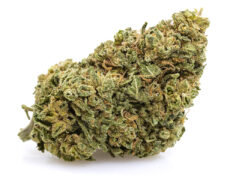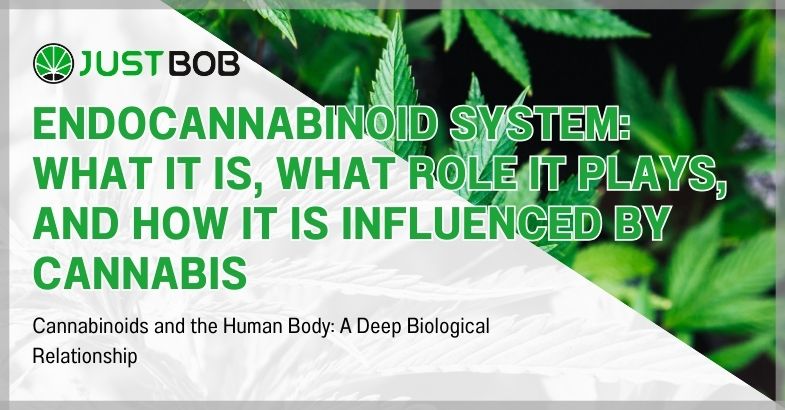Modified on: 04/12/2024
Cannabinoids and the Human Body: A Deep Biological Relationship
In the following article, we will explore the complex network of components and functions that characterize the endocannabinoid system (ECS), a biological system crucial for maintaining balance and regulating multiple processes in the human body.
We will delve into the roles of the cannabinoid receptors CB1 and CB2, endogenous cannabinoids such as anandamide and 2-AG, and the enzymes that regulate their synthesis and degradation.
-
 SMALL & BIG
SMALL & BIGBUBBLEGUM
Indoor | CBD – CBDA < 22%
Starting from:EASTER SALE -10%
1,25CHF1,10CHF/gGrams3 5 10 20 50 100 -



DO SI DOS
Starting from: 2,00CHF/gIndoor | CBD – CBDA < 19%
Grams3 5 10 20 50 100 -



ROYAL GG#4
Starting from: 2,30CHF/gIndoor | CBD – CBDA < 40%
Grams3 5 10 20 50 100 -



GORILLA GLUE
Starting from: 2,90CHF/gIndoor | CBD – CBDA < 20%
Grams3 5 10 20 50 100
We will also examine the interactions between the ECS and cannabis cannabinoids, such as THC and CBD , analyzing their influences on bodily functions and therapeutic potential. This article aims to provide a clear and up-to-date overview of the endocannabinoid system, highlighting its importance in health and medical research .
Read also: The story of the Hemp Body Car
The endocannabinoid system: a general overview
The endocannabinoid system is a fundamental component of our body, responsible for regulating numerous physiological functions . It is mainly composed of three elements: cannabinoid receptors, endogenous cannabinoids and the enzymes that synthesize and degrade them.
The most well-known cannabinoid receptors are the CB1 and CB2 receptors . The former are found predominantly in the central nervous system, influencing processes such as pain, mood and appetite, while the latter are more present in the immune system and are therefore involved in immune and inflammatory response functions.
Endogenous cannabinoids , such as anandamide and 2-AG, are molecules produced by our body that interact with these receptors. These compounds play a crucial role in maintaining internal balance (so-called homeostasis), regulating extremely important functions such as sleep, appetite, pain perception, and immune responses.
Enzymes of the endocannabinoid system , such as Fatty Acid Amide Hydrolase (FAAH) and Monoacylglycerol Lipase (MAGL), are responsible for the synthesis and degradation (i.e. elimination) of endogenous cannabinoids, thus ensuring precise control of their presence and activity in the body.
Research on the endocannabinoid system is constantly evolving, offering new perspectives for the understanding of various medical conditions and for the development of innovative therapies.
How are endocannabinoids produced in the human body?
The synthesis and release of endogenous cannabinoids are key processes in the functioning of the endocannabinoid system.
These compounds, such as anandamide and 2-arachidonoylglycerol (2-AG), are produced ‘on demand’ by the cells of our body . This means that they are synthesized and released in response to specific cellular stimuli, rather than being stored in advance.
The production of anandamide occurs through the transformation of a membrane precursor, phosphatidylethanolamine, in a series of enzymatic steps. In particular, a key enzyme, phospholipase D, plays a crucial role in this process.
As for 2-AG, its synthesis is still the subject of in-depth studies. However, it is known that this molecule is produced mainly through the cleavage of another membrane lipid, diacylglycerol, by the action of specific enzymes.
Once synthesized, these endogenous cannabinoids are released from cells and interact with cannabinoid receptors, performing various biological functions. After exerting their effects, they are rapidly degraded by other enzymes , such as FAAH for anandamide and MAGL for 2-AG, to prevent excessive stimulation of the endocannabinoid system. This mechanism ensures a dynamic balance and fine regulation of bodily functions.


These are the functions regulated by the SEC
The endocannabinoid system plays a crucial role in regulating a wide range of physiological functions. Among these, the best known is the modulation of pain and inflammation : based on this characteristic, endogenous cannabinoids act as mediators in the control of pain, influencing the perception of the latter at the level of the central and peripheral nervous system.
Another key aspect is the control of appetite, metabolism and energy balance . Cannabinoid receptors in the brain are involved in regulating hunger and responding to food odors.
Additionally, the endocannabinoid system also plays a key role in regulating mood and stress response : it acts on areas of the brain involved in managing anxiety and depression, offering potential therapeutic targets for these conditions.
Finally, as already mentioned, we should not forget its role in controlling immune function , a detail that for years has paved the way for interesting research on potential treatments for autoimmune and inflammatory diseases.
So what does cannabis have to do with the endocannabinoid system?
The clinical and therapeutic implications of the endocannabinoid system are enormous, as can be easily understood from the role it plays in the homeostasis of the human body.
But what does all this have to do with cannabis?
Well, as explained, the endocannabinoid system is modulated by molecules called, precisely, endocannabinoids: a way of specifying that they are cannabinoids produced inside (endo) our body. In essence, these are molecules with functions extremely similar to the phytocannabinoids contained in plants. And among these, as is known, are the very famous tetrahydrocannabinol (THC) and cannabidiol (CBD).
In short, by their very nature, these molecules contained in cannabis (the plant also contains other cannabinoids, but these two are the most relevant) are able to interact with the endocannabinoid system and therefore influence numerous processes that occur in our body.
Let’s look at their characteristics in more detail and how they influence the SEC.
A Quick Recap on the Characteristics of THC and CBD
THC is the most well-known psychoactive compound in cannabis. It acts primarily on CB1 receptors, which, as mentioned, are found in large quantities in the central nervous system, and determines the euphoric effects or ‘high’ typically associated with marijuana use . THC also affects other functions such as sleep, appetite (think of the so-called ‘munchies’), pain perception and memory.
CBD, on the other hand, is not psychoactive and does not have euphoric effects . So much so that the cannabis light that is so much talked about is legal precisely because it contains mainly cannabidiol, and practically no trace of THC. And this is true for any type of certified and controlled product, starting from the well-known CBD oil to the more particular ones, such as legal hashish and cannabidiol crystals.
CBD has gained attention in recent years for its potential therapeutic properties as mentioned in the previous paragraph: it interacts with the CB1 and CB2 receptors. In particular, several studies have shown that CBD can have anti-inflammatory, analgesic, anxiolytic and anticonvulsant effects .
It must be said, however, that its mechanism of action is less direct than THC, as we will see in the next paragraph.
How do cannabinoids interact with the ECS?
The interaction of cannabinoids with CB1 and CB2 receptors is a fundamental aspect of understanding the effects of cannabis on the human body.
When THC, the main psychoactive compound in cannabis, binds to CB1 receptors , it causes effects that include altered perception, euphoria, and relaxation, as well as influencing memory, concentration, and motor coordination. These are well-known effects to the general public, but what is less known is the fact that tetrahydrocannabilol, by interacting with the aforementioned receptors, can also have therapeutic effects, such as pain relief and nausea reduction.
On the other hand, cannabidiol, which is not psychoactive, interacts with the CB1 and CB2 receptors in a more complex and less direct way . This compound can modulate the effects of THC, for example by reducing anxiety or psychosis that can be induced by the latter. In addition, it has demonstrated potential therapeutic benefits such as anti-inflammatory, analgesic, anxiolytic and anticonvulsant action.
A detailed understanding of how these cannabinoids interact with CB1 and CB2 receptors is crucial not only to unravel the mechanisms underlying the effects of cannabis, but also to develop effective and safe medical treatments based on these compounds.
The therapeutic potential of cannabinoids
Now that we have a clearer vision of the characteristics of CBD and THC and the dynamics that concern their interaction with the ECS, let’s briefly see, in concrete terms, how this knowledge is put into practice in modern medicine.
Cannabinoid-based therapies are a rapidly evolving field, offering new perspectives for the treatment of various conditions.
CBD, for example, has shown potential as a supportive treatment for some forms of epilepsy, leading to the approval of specific medications for these conditions. Other research indicates the potential for CBD and THC to manage chronic pain , especially that associated with conditions such as arthritis and multiple sclerosis.


Furthermore, cannabinoids are gaining attention in the treatment of symptoms associated with oncological conditions , such as nausea and loss of appetite caused by chemotherapy. Some research, perhaps overly optimistic, has even been directed at studying a possible role of cannabinoids in slowing the growth of some types of tumor cells. But, it is worth noting, so far no data has emerged to prove this hypothesis.
It is important to emphasize that, despite the encouraging progress, research on cannabinoids as a therapy is still in a relatively early stage . Years and years of studies are still needed to fully understand their therapeutic potential and, above all, the possible side effects.
But this is an absolutely necessary effort because the complexity of cannabis and its compounds requires a rigorous and detailed scientific approach to fully exploit its therapeutic potential.
Read also: Do CBD and yoga belong together?
In conclusion
The understanding of the endocannabinoid system, which we hope will be further deepened, opens the way to new horizons in the therapy of various pathologies, underlining the importance of endogenous cannabinoids and, in part, also those derived from cannabis. The progress in this field not only expands our knowledge of the functioning of the human body, but also offers concrete hopes for the development of more effective and targeted treatments .
In short, there is still much to discover on this topic, but the data obtained from the research carried out to date are still comforting and have pushed, even in Italy, the authorities to allow the use of cannabis in the therapeutic field for various pathologies. A use, we would like to specify, that is permitted only through specially packaged medicines, prescribed by a specialist .
We emphasize this because there are those who think that even legal cannabis products can be consumed for medical purposes: we are talking about items such as, for example, CBD oil , or light hemp inflorescences .
Well, all these products, also available here on our Justbob shop , can be purchased exclusively for collection purposes, or for decorating and perfuming environments. Other intended uses, such as consumption for both therapeutic and recreational purposes, are not currently permitted by Italian law .
Takeaways
- The endocannabinoid system (ECS) regulates a wide range of physiological functions, including pain, appetite, mood, and immune responses, playing a fundamental role in homeostasis.
- Anandamide and 2-AG, endogenous cannabinoids, are produced in response to specific cellular stimuli and act by interacting with the cannabinoid receptors CB1 and CB2, playing crucial roles in regulating bodily functions.
- THC and CBD, present in cannabis, interact with the ECS, influencing various bodily processes. While THC is psychoactive and acts primarily on CB1 receptors, CBD is non-psychoactive and has more complex effects, modulating the effects of THC and showing potential therapeutic benefits.
- Cannabinoids have shown therapeutic promise in the treatment of conditions such as epilepsy, chronic pain, and symptoms related to cancer. However, research is still ongoing to fully understand their therapeutic potential and possible side effects.
- Despite the progress, a rigorous scientific approach is needed to fully exploit the therapeutic potential of cannabinoids, highlighting the importance of continued research in this field for the development of effective and targeted treatments.
Questions & Answers
What is the endocannabinoid system?
The endocannabinoid system (ECS) is a biological system crucial for maintaining balance and regulating multiple processes in the human body. It is mainly composed of cannabinoid receptors, endogenous cannabinoids, and enzymes that regulate their synthesis and degradation.
What are the main components of the endocannabinoid system?
The endocannabinoid system is mainly composed of cannabinoid receptors (CB1 and CB2), endogenous cannabinoids (such as anandamide and 2-AG), and enzymes involved in their synthesis and degradation.
What are the functions regulated by the endocannabinoid system?
The endocannabinoid system regulates several physiological functions, including pain, inflammation, appetite, sleep, mood, memory, and immune response.







